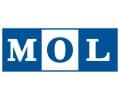Naming and Launching Ceremony for the Sunflower Kamuy Held 1st LNG-fueled Ferry on Oarai-Tomakomai Route

Mitsui O.S.K. Lines, Ltd. (MOL; President & CEO: Takeshi Hashimoto) and its group company MOL Sunflower Ltd. (MOL Sunflower; President & CEO: Hirotoshi Ushioku; Headquarters: Chiyoda-ku, Tokyo) today announced that the naming and launching ceremony for the first of two LNG-fueled ferries, which are under construction at Naikai Zosen Corporation (President: Kosaku Hara; Headquarters: Onomichi-shi, Hiroshima Prefecture), was held at Innoshima Shipyard on April 11.
The vessel was given its name Sunflower Kamuy by Tomoyasu Marutani, Chairman of Secoma Company Limited, and then his wife, Michiko Marutani, performed the ceremonial rope cutting. The vessel will be delivered at Naikai Shipbuilding in December 2024 and is slated to enter service on the late-night Oarai-Tomakomai route operated by MOL Sunflower in early 2025. The second of the two new vessels is scheduled to enter service on the same route within 2025.

The LNG-fueled ferry Sunflower Kamuy
With the addition of these vessels, the MOL Group will operate a fleet of four LNG-fueled ferries on east-west routes in Japan by 2025, joining the Sunflower Kurenai and Sunflower Murasaki, which went into service on the Osaka-Beppu route in 2023.
About the Sunflower Kamuy>
■Origin of the ship’s name
Showing reverence for the Ainu, the great predecessors who first inhabited the northern part of the Japanese archipelago, centering on Hokkaido, the Ainu name for the new generation of LNG-fueled vessels represents the vessel’s connection to tradition and the future, and the MOL Group was conscious of evoking the image of Hokkaido, the destination of the vessel. Ainu traditions also hold that kamuy (a great power like gods or souls) exist in everything around humans and are always watching over them, so it named the vessel the Sunflower Kamuy in conjunction with the group’s ferry business brand name, in the hope that the vessel will protect the richness of the ocean and the irreplaceable global environment.
■Hull design
With the design concept “to protect our irreplaceable earth and seas while bridging the traditions we have inherited and the future we endeavor to forge, continuing to brighten people’s lives,” the beautiful “blue” of the sea and sky is used as an accent color. The design is inspired by the “sea at dawn” and the “light illuminating a new era,” expressing the idea of the vessel setting sail toward a new future.
The vessel will be able to reduce CO2 emissions by about 35% compared to currently in-service vessels on the Hokkaido route by adopting various state-of-the-art technologies in addition to LNG fuel, thereby contributing to the reduction of overall CO2 emissions.
In addition, the MOL Group will promote Japan’s “Modal Shift” and strive to solve the “2024 problem of logistics,” by expanding the loading space for trucks compared to the currently in-service vessels and providing more comfortable space for truck drivers by making all cabins private rooms.
The MOL Group aims to achieve net zero greenhouse gas (GHG) emissions by 2050, and will continue to carry forward the strategy of “adoption of clean alternative fuels” in line with the “MOL Group Environmental Vision 2.2” to achieve decarbonization and low carbonization. In addition to leading the way in environmental responsiveness in the coastal ferry business, the group will continue to research and examine the use of new fuels as alternatives to LNG in the future, and will continue to actively lead the industry in this area.
Source: Mitsui O.S.K. Lines
